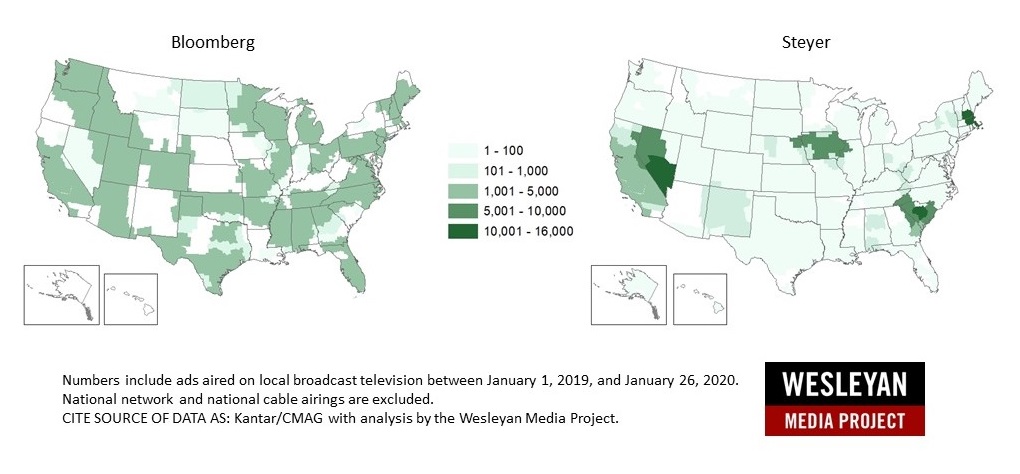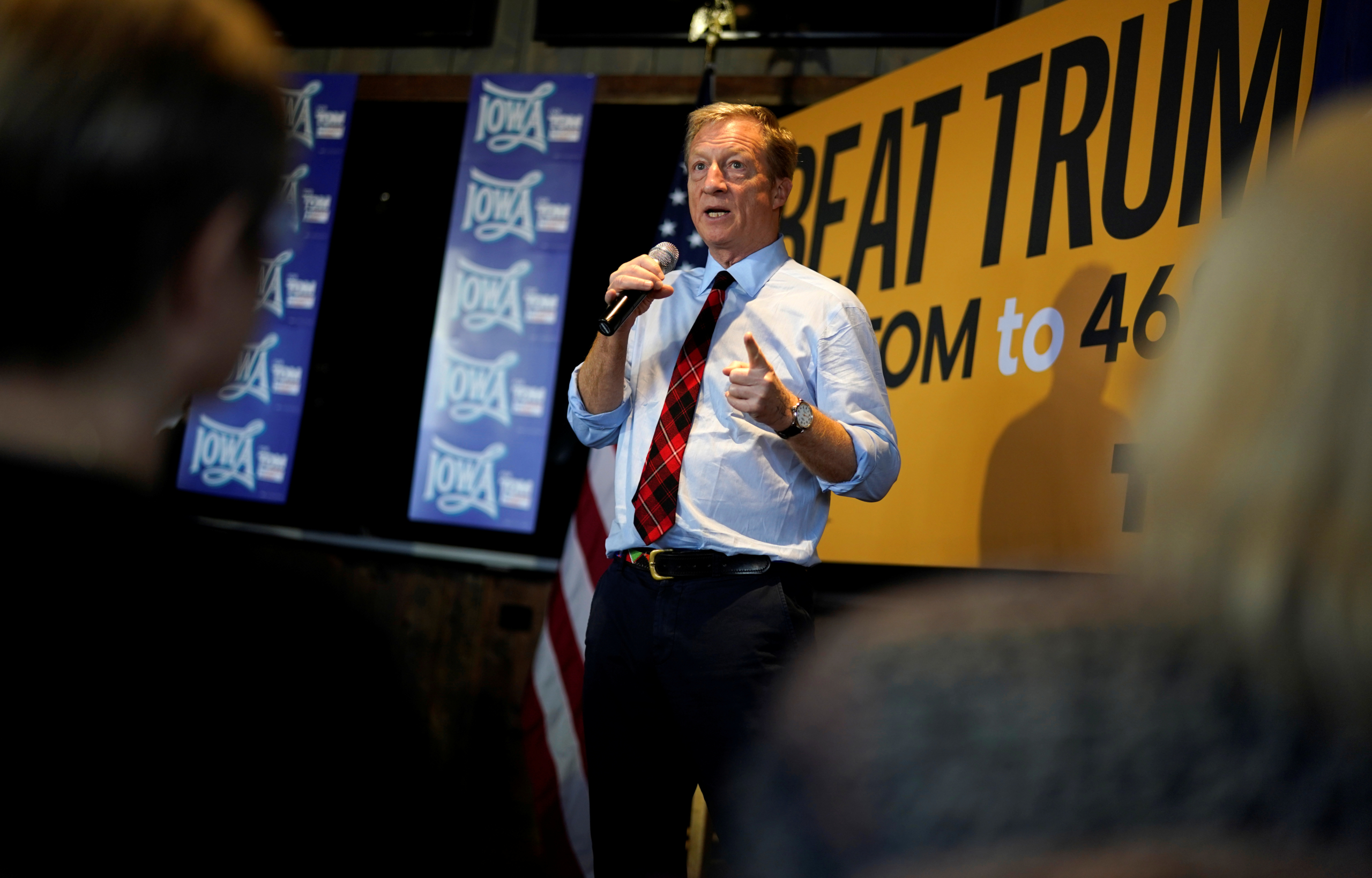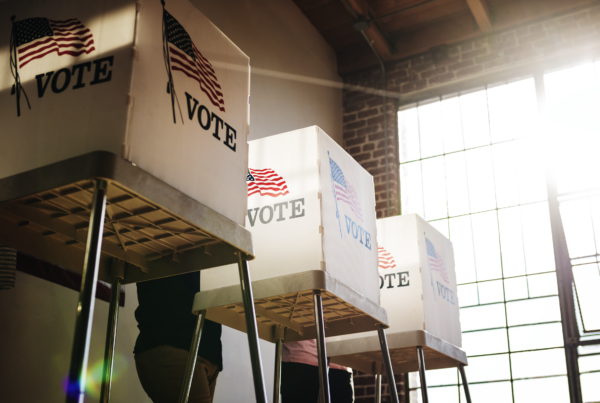Photo: Rick Wilking/Reuters
Self-funded billionaires drive ad spending up 131% over 2016
(MIDDLETOWN, CT) January 29, 2020 – A new analysis from the Wesleyan Media Project shows that over $44 million has been spent on 122,815 broadcast television presidential ads in Iowa, which holds the nation’s first caucus on Monday, February 3 (Table 1). These totals in Iowa represent an 11 percent increase in presidential ad spending over 2016 (which saw $40 million) and a 65 percent increase in airings (74,483 ads aired at this point in 2016). Tom Steyer’s campaign has spent over $11 million on over 37,000 ads, while Pete Buttigieg’s campaign has spent over $6 million on a third of that total (12,289 airings), and Bernie Sanders’ campaign has spent $5.8 million for 20,272 airings. The campaigns of Andrew Yang, Elizabeth Warren and Joe Biden have also spent more than $3 million each on the presidential race in Iowa.
Table 1: Presidential Ad Airings and Spending by Sponsor (Iowa Only)
| Sponsor | Airings | Est. Spending ($) | * |
|---|---|---|---|
| Steyer, Tom | 37,215 | 11,338,623 | 1 |
| Buttigieg, Pete | 12,289 | 6,605,561 | 2 |
| Sanders, Bernie | 20,272 | 5,859,636 | 3 |
| Yang, Andrew | 14,491 | 4,402,755 | 4 |
| Warren, Elizabeth | 10,829 | 3,511,922 | 5 |
| Biden, Joe | 9,168 | 3,066,514 | 6 |
| Klobuchar, Amy | 4,469 | 1,835,225 | 7 |
| Bennet, Michael | 1,565 | 843,185 | 8 |
| Gillibrand, Kirsten | 2,338 | 688,120 | 9 |
| Trump, Donald | 992 | 481,795 | 10 |
| Delaney, John | 1,379 | 450,730 | 11 |
| Bullock, Steve | 809 | 402,475 | 12 |
| Harris, Kamala | 809 | 389,345 | 13 |
| Bloomberg, Michael | 737 | 375,464 | 14 |
| Booker, Cory | 447 | 179,950 | 15 |
| Gabbard, Tulsi | 562 | 172,670 | 16 |
| Castro, Julian | 50 | 23,500 | 17 |
| Gravel, Mike | 5 | 7,700 | 18 |
| 19 | |||
| Unite the Country | 3318 | 3,026,527 | 20 |
| Act Now on Climate | 756 | 419,205 | 21 |
| United We Win Super PAC | 266 | 220,230 | 22 |
| National Biodiesel Board | 43 | 25,775 | 23 |
| Club for Growth | 6 | 21,800 | 24 |
| 26 | |||
| Iowa Total | 122,815 | 44,348,707 | 27 |
| Numbers include ads aired on broadcast television in Iowa between January 1, 2019, and January 26, 2020. *The final column can be used to return to the original sorting of the table. CITE SOURCE OF DATA AS: Kantar/CMAG with analysis by the Wesleyan Media Project. | |||
By and large, spending has come from the candidates’ campaign as opposed to outside groups. The heaviest spending group is Unite the Country, a single-candidate super PAC supportive of Joe Biden, which has put $3 million into the race in Iowa. The United We Win super PAC, which supported Cory Booker, spent about $200,000 on ads in the state.
Presidential TV Ad Spending More Than Double 2016 Totals
Of course, Iowa is not the only state being inundated by ad spending. So far, an estimated $367 million has been spent on 513,437 political ads in the presidential race (Table 2), an increase of 131 percent over 2016 spending and 227 percent over 2016 ad volume.
Table 2: Presidential Ad Airings and Spending by Election Cycle
| Cycle | Airings | Est. Spending (Ms) |
|---|---|---|
| 2020 | 513,437 | 367.5 |
| 2016 | 156,935 | 158.9 |
| 2012 | 116,351 | 60.9 |
| 2008 | 151,430 | 106.7 |
| 2004 | 72,754 | 45.3* |
| 2000 | 30,185 | 25.3** |
| Numbers include ads aired on national network, national cable and broadcast television between January 1 of the year prior to the election and January 26 of election year. *Denotes data from the top 100 media markets only. **Denotes data from the top 75 media markets only. Totals are not adjusted for inflation. CITE SOURCE OF DATA AS: Kantar/CMAG with analysis by the Wesleyan Media Project. |
||
“Ad spending in this nomination race is crushing records,” said Erika Franklin Fowler, co-director of the Wesleyan Media Project, “and the main reason for that is the presence of Bloomberg and Steyer, the two self-funded billionaires.”
By this point in 2016, $159 million had been spent on 156,935 ads in the presidential race, while in 2012, $61 million had been spent on 116,935 presidential ads by January 26. Presidential ad spending as of January 26, 2008 had amounted to $106 million for 151,430 ads.
Table 3 breaks down spending in 2019 and early 2020 by sponsor—both candidates and groups—for those spending more than $100,000. Two candidates top the list: Michael Bloomberg, with an estimated $196 million in ad spending, and Tom Steyer, who has spent $113 million so far. The drop in ad spending after these two billionaires is considerable. Bernie Sanders’ campaign has spent just under $10 million, while Pete Buttigieg has spent about $9 million. Andrew Yang has spent $8 million on ads, followed by Donald Trump with $7 million in ad spending.
Table 3: Presidential Ad Airings and Spending by Sponsor (All Markets)
| Sponsor | Airings | Est. Spending | * |
|---|---|---|---|
| Bloomberg, Michael | 232,196 | 196,776,746 | 1 |
| Steyer, Tom | 164,460 | 113,735,114 | 2 |
| Sanders, Bernie | 30,627 | 9,851,314 | 3 |
| Buttigieg, Pete | 16,294 | 8,933,018 | 4 |
| Yang, Andrew | 22,703 | 8,082,533 | 5 |
| Trump, Donald | 4,665 | 6,965,939 | 6 |
| Warren, Elizabeth | 11,317 | 3,817,461 | 7 |
| Biden, Joe | 9,261 | 3,239,542 | 8 |
| Klobuchar, Amy | 5,483 | 2,343,036 | 9 |
| Gillibrand, Kirsten | 2,788 | 1,099,870 | 10 |
| Bennet, Michael | 1,635 | 900,226 | 11 |
| Gabbard, Tulsi | 1,660 | 578,250 | 12 |
| Delaney, John | 1,439 | 543,230 | 13 |
| Harris, Kamala | 810 | 402,845 | 14 |
| Bullock, Steve | 809 | 402,475 | 15 |
| Booker, Cory | 447 | 179,950 | 16 |
| Shawe , Shirley | 34 | 117,700 | 17 |
| 18 | |||
| Unite the Country | 3,320 | 3,038,527 | 19 |
| Need to Impeach | 41 | 1,555,400 | 20 |
| Judicial Crisis Network | 40 | 1,100,000 | 21 |
| AB PAC | 631 | 1,034,140 | 22 |
| AB Foundation | 975 | 790,750 | 23 |
| Act Now on Climate | 786 | 776,205 | 24 |
| Planned Parenthood Action Fund | 8 | 253,030 | 25 |
| Reason to Believe PAC | 110 | 232,140 | 26 |
| United We Win Super PAC | 266 | 220,230 | 27 |
| Votevets | 68 | 163,755 | 28 |
| Senate Leadership Fund | 327 | 105,300 | 29 |
| Defend American Democracy | 10 | 104,500 | 30 |
| Numbers include ads aired on national network, national cable and broadcast television between January 1, 2019, and January 26, 2020. CITE SOURCE OF DATA AS: Kantar/CMAG with analysis by the Wesleyan Media Project. |
|||
Joe Biden, currently in the lead in many polls, has spent only $3.2 million on ads, but his campaign has been aided by the super PAC Unite the Country, which has spent $3 million in support of his candidacy. By and large, though, group spending in the presidential race has been minimal. Tom Steyer’s Need to Impeach spent about $1.5 million (mostly before he entered the race), and the Judicial Crisis Network, a pro-Trump group, spent around $1 million in the summer of 2019.
Bloomberg, Steyer Take Different Strategies
While Bloomberg and Steyer are both spending enormous amounts of money on political advertising, they are spending that money in different places, as shown in Figure 1. In addition to leading advertising in Iowa by large margins, Steyer is also concentrating his ad buys in early nomination states, notably South Carolina, New Hampshire and Nevada. Bloomberg, by contrast, is taking a much broader approach. While Steyer’s advertising has appeared in more markets overall (185 of the 210 compared to 138 for Bloomberg), many of these buys were very low in volume.
“Michael Bloomberg seems to be taking pains to avoid advertising in the first four states to cast ballots,” said Travis Ridout, co-director of the Wesleyan Media Project. “But by focusing his advertising in the states that vote later, he has the airwaves almost to himself—at least for now. And the volume of airings will have made them hard to miss.”
Figure 1: Bloomberg & Steyer Advertising by Market

Download figure data as a spreadsheet.
Top Presidential Advertisers in Historical Perspective
To help put Bloomberg and Steyer’s advertising into context, the WMP compiled spending on presidential advertising from the 1999-2000 cycle onward as shown in Table 4. Prior to
Bloomberg’s and Steyer’s multi-million-dollar ad buys, the biggest spender in the presidential nomination race (through January 26 of election year) was Right to Rise, the single-candidate super PAC that supported Jeb Bush in 2016. The biggest candidate spender prior to the current election cycle was Mitt Romney in 2008, whose campaign spent $28 million on ads.
“While Bloomberg and Steyer have shattered spending records for television ads in the nomination race, the other 2020 candidates have been quite sparing in their television ad spending,” said Michael Franz, co-director of the Wesleyan Media Project. “Bernie Sanders’ $9.9 million in ad spending, for instance, is well below spending by other candidates in 2008 and 2016, including himself four years ago.”
In terms of the number of ad airings, however, Sanders in 2020 ranks behind only Bloomberg, Steyer and Romney in 2008.
Table 4: Top Presidential Sponsors (Through Jan 26) From Past Six Cycles
| Sponsor | Airings | Est. Spending (Ms) | Cycle |
|---|---|---|---|
| Bloomberg, Michael | 232,196 | 196.8 | 2020 |
| Steyer, Tom | 164,460 | 113.7 | 2020 |
| Right to Rise USA | 26,875 | 50.4 | 2016 |
| Romney, Mitt | 34,229 | 28.1 | 2008 |
| Obama, Barack | 28,861 | 21.8 | 2008 |
| Clinton, Hillary | 25,291 | 18.3 | 2008 |
| Clinton, Hillary | 29,850 | 17.5 | 2016 |
| Sanders, Bernie | 26,800 | 14.1 | 2016 |
| America Leads | 4,078 | 10.8 | 2016 |
| Conservative Solutions PAC | 6,224 | 10.8 | 2016 |
| Dean, Howard | 18,316 | 10.6 | 2004* |
| Crossroads Grassroots Policy Strategies | 14,433 | 10.5 | 2012 |
| Sanders, Bernie | 30,627 | 9.9 | 2020 |
| Bush, George | 11,737 | 9.0 | 2000** |
| Restore Our Future, Inc. | 14,605 | 9.0 | 2012 |
| Buttigieg, Pete | 16,294 | 8.9 | 2020 |
| Rubio, Marco | 11,533 | 8.6 | 2016 |
| Romney, Mitt | 15,998 | 8.4 | 2012 |
| Edwards, John | 14,732 | 8.3 | 2008 |
| New Day For America | 2,580 | 8.3 | 2016 |
| Yang, Andrew | 22,703 | 8.1 | 2020 |
| Conservative Solutions Project | 4,882 | 7.5 | 2016 |
| Clark, Wesley | 10,501 | 7.5 | 2004* |
| McCain, John | 10,461 | 7.4 | 2008 |
| Trump, Donald | 4,665 | 7.0 | 2020 |
| Numbers include ads aired on national network, national cable and broadcast television between January 1 of the off-year and January 26 of the election year. *Denotes data from the top 100 media markets only. **Denotes data from the top 75 media markets only. Totals are not adjusted for inflation. CITE SOURCE OF DATA AS: Kantar/CMAG with analysis by the Wesleyan Media Project. 2000-2004 data available through the Wisconsin Advertising Project. |
|||
About This Report
The Wesleyan Media Project (WMP) provides real-time tracking and analysis of political advertising in an effort to increase transparency in elections. Housed in Wesleyan’s Quantitative Analysis Center (QAC) – part of the Allbritton Center for the Study of Public Life – the Wesleyan Media Project is the successor to the Wisconsin Advertising Project, which disbanded in 2009. It is directed by Erika Franklin Fowler, associate professor of government at Wesleyan University, Michael M. Franz, professor of government at Bowdoin College and Travis N. Ridout, professor of political science at Washington State University. WMP personnel include Laura Baum (Project Manager), Colleen Bogucki (Project Coordinator), Pavel Oleinikov (Associate Director, QAC), and Courtney Page-Tan (Post-Doctoral Fellow).
The Wesleyan Media Project is supported by Wesleyan University,
the John S. and James L. Knight Foundation, and the Democracy Fund. WMP is partnering again this year with the Center for Responsive Politics, to provide added information on outside group disclosure.
Periodic releases of data will be posted on the project’s website and dispersed via Twitter @wesmediaproject. To be added to our email update list, click here.
For more information contact:
Lauren Rubenstein, lrubenstein@wesleyan.edu,
(860) 685-3813 or (203) 644-7144
About Wesleyan University
Wesleyan University, in Middletown, Conn., is known for the excellence of its academic and co-curricular programs. With more than 2,900 undergraduates and 200 graduate students, Wesleyan is dedicated to providing a liberal arts education characterized by boldness, rigor and practical idealism. For more, visit wesleyan.edu.
About the John S. and James L. Knight Foundation
Knight Foundation is a national foundation with strong local roots. We invest in journalism, in the arts, and in the success of cities where brothers John S. and James L. Knight once published newspapers. Our goal is to foster informed and engaged communities, which we believe are essential for a healthy democracy.
About Democracy Fund
Created by eBay founder and philanthropist Pierre Omidyar, Democracy Fund is a foundation helping to ensure that our political system can withstand new challenges and deliver on its promise to the American people. Democracy Fund has invested more than $125 million in support of a healthy, resilient, and diverse democracy with a particular focus on modern elections, effective governance, and a vibrant public square.




